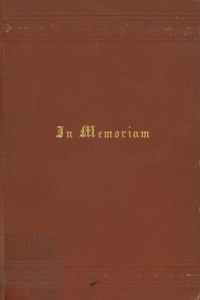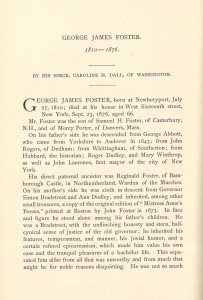 There is much serendipity in genealogy: more than once I have pulled a book off the shelf in the library at NEHGS, intrigued by the title or perhaps the binding, only to find within its covers the answer to a vexing research question or a story that sheds light on a forgotten family member. One such volume is H.U. Memoirs, published in Boston in 1886, the earliest Harvard class book – not including the Sibley’s Harvard Graduates volumes – on the Society’s open shelves. In it I found a charming short biography of my great-great-great-great-uncle George James Foster (1810–1876), written by his niece Caroline Healey Dall.
There is much serendipity in genealogy: more than once I have pulled a book off the shelf in the library at NEHGS, intrigued by the title or perhaps the binding, only to find within its covers the answer to a vexing research question or a story that sheds light on a forgotten family member. One such volume is H.U. Memoirs, published in Boston in 1886, the earliest Harvard class book – not including the Sibley’s Harvard Graduates volumes – on the Society’s open shelves. In it I found a charming short biography of my great-great-great-great-uncle George James Foster (1810–1876), written by his niece Caroline Healey Dall.
A member of the Harvard Class of 1830 – which included Foster’s close friend Charles Sumner – George “stood alone among his father’s children. He was a Bradstreet, with the unflinching honesty and stern, half-cynical sense of justice of the old governor; he inherited [Simon Bradstreet’s] features, temperament, and manner, his jovial humor, and a certain refined epicureanism, which made him value his own ease and the tranquil pleasures of a bachelor life.” One of Caroline’s earliest memories is of George’s “Commencement dinner, not yet superseded by the meaningless Class-Day collation,” in 1830. “The table, glowing with silver and crystal, spread with dainties concocted from the old Bradstreet recipes by loving hands; the glad games of ball and marbles which he and his classmates were not too proud to start for his baby nieces, now [in 1886] seem nearer than many things which happened yesterday.” (pp. 86, 87)
But Nemesis stalked George’s father, who had survived the Newburyport Fire of 1811 (“and the horrors of the three days’ starvation which followed”) only for his business – relocated to Boston – to fail. George’s parents moved to New York to start anew, and George withdrew from Harvard Law School, shipping out as a super-cargo to China on a ship belonging to his brother-in-law, Mark Healey. He moved on to Rio de Janeiro, Lima, and then Valparaiso, where he became a partner in the mercantile firm of Alsop & Company in 1860.
Further reminiscences of George Foster may be found in his peripatetic English friend Henry Swinglehurst’s book, Silver Mines and Incidents of Travel: Letters and Notes on Sea and Land (1893). He was delighted to encounter Foster in Panama City in August 1860: “In old chat and jokes, and talk about personal hopes and trials, Foster and I spent some joyous hours in two days up to the time for the departure for Peru – days passing as happily as I could desire. Foster is a well read man, a great talker, full of humour, and in appearance like [the actor William Charles] Macready, he is a charming talker at his own table, and says he never forgets what he reads; he is a Bostonian.” (p. 220)
Three years later, Uncle George was still in Chile while Swinglehurst was in New York, staying in “a fine elegant house belonging to my friend Foster of Valparaiso and now occupied by his brother on his account … Mr. Charles Foster is surrounded with a circle of wealthy and educated men, who are attached to him and his brother with singular ties of affection – these include merchants, judges, lawyers, doctors, and men of fortune not in business – and they receive me with family generosity as a friend of their friend of Valparaiso. In conversation and discussion we have allowed no topic of politics or social life to be too sacred, and I have talked with them on all points of difference between England and the United States about their [Civil War].” (p. 305)
 Cousin Caroline Dall describes how, after his South American adventures, Uncle George retired to his house on West Sixteenth Street, his health “impaired by severe attacks of fever, contracted in crossing the Andes, before roads or railways existed to make the passage easy. He made small mention of his own sufferings, content to bear them patiently, and forget them, as far as possible, in the travels and biographies with which he beguiled his leisure…
Cousin Caroline Dall describes how, after his South American adventures, Uncle George retired to his house on West Sixteenth Street, his health “impaired by severe attacks of fever, contracted in crossing the Andes, before roads or railways existed to make the passage easy. He made small mention of his own sufferings, content to bear them patiently, and forget them, as far as possible, in the travels and biographies with which he beguiled his leisure…
“Mr. Foster was the last survivor of his father’s family [when he died in 1876]. His body was laid in the Second Street Marble Cemetery, of the city of New York, by the side of those who had gone before.” (H.U. Memoirs, p. 88)
Share this:
About Scott C. Steward
Scott C. Steward has been NEHGS’ Editor-in-Chief since 2013. He is the author, co-author, or editor of genealogies of the Ayer, Le Roy, Lowell, Saltonstall, Thorndike, and Winthrop families. His articles have appeared in The New England Historical and Genealogical Register, NEXUS, New England Ancestors, American Ancestors, and The Pennsylvania Genealogical Magazine, and he has written book reviews for the Register, The New York Genealogical and Biographical Record, and the National Genealogical Society Quarterly.View all posts by Scott C. Steward →